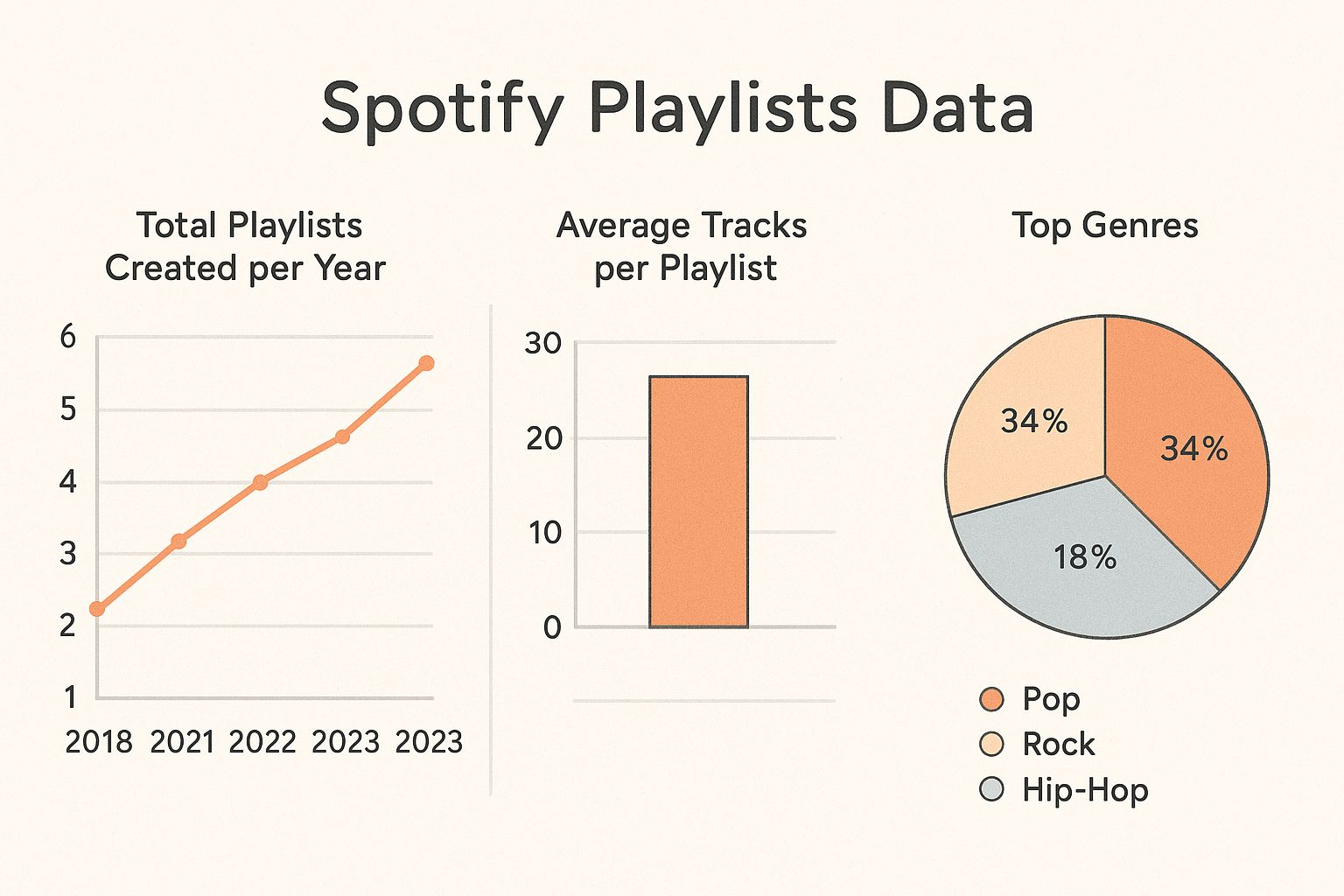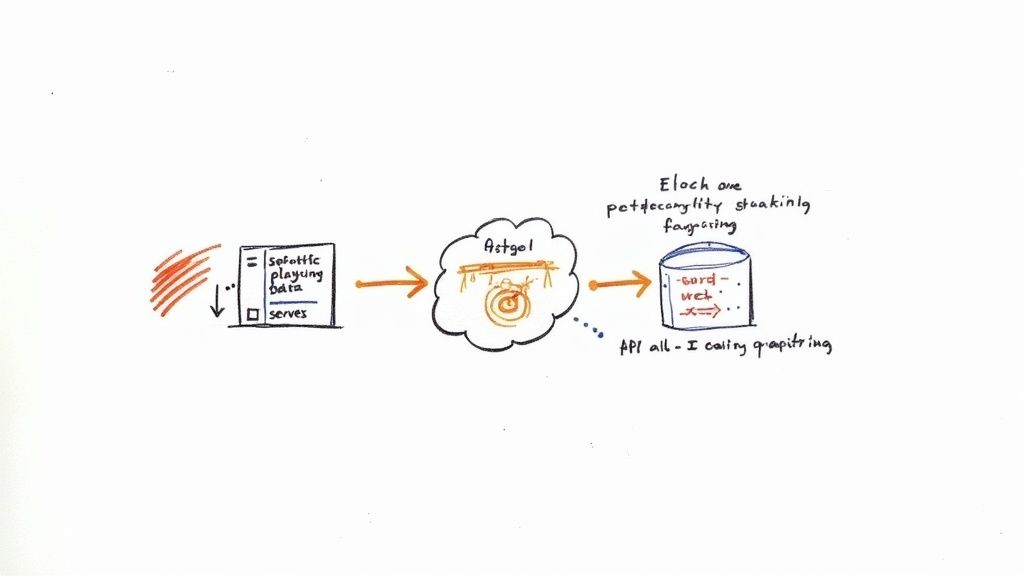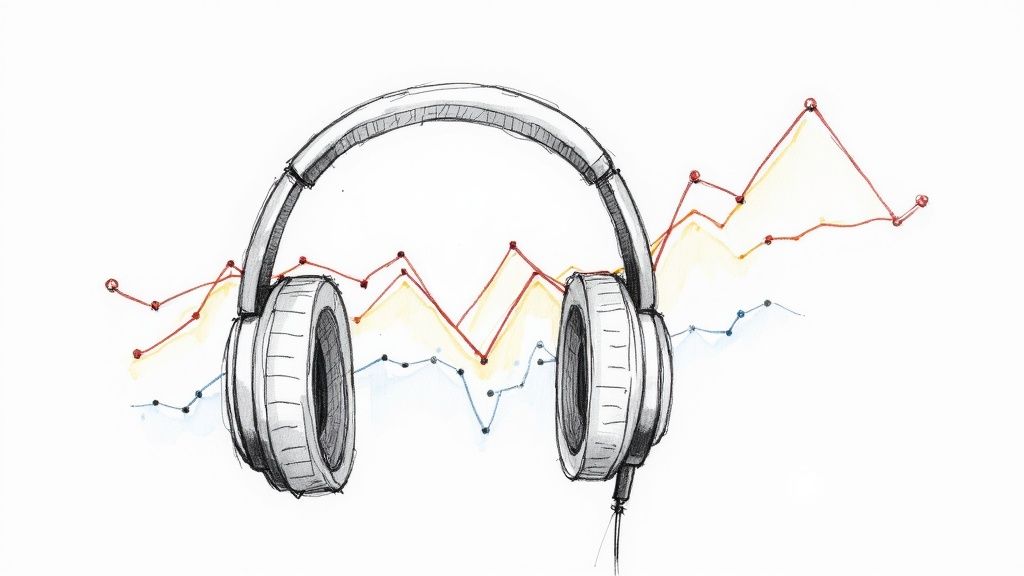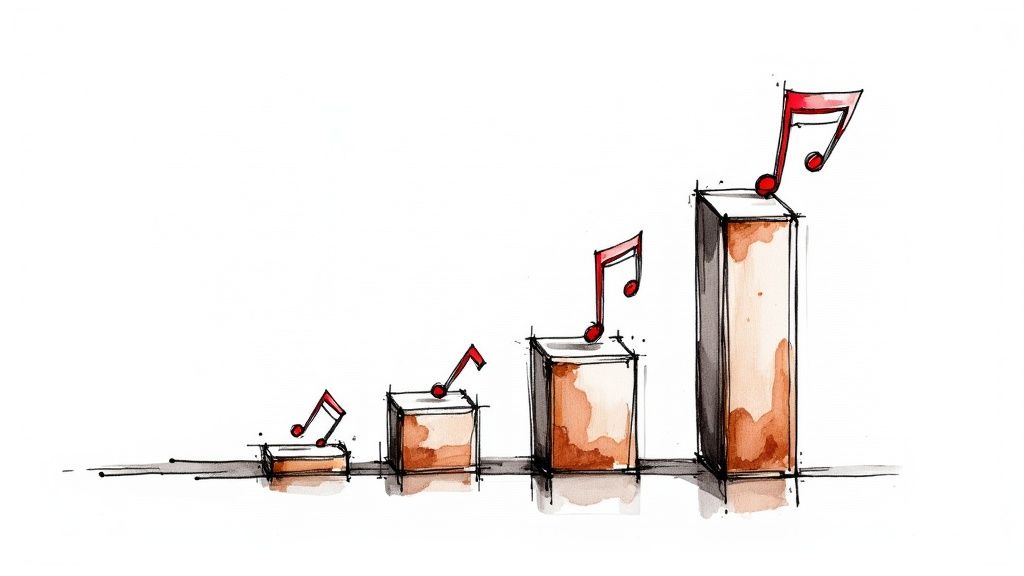Unlock Insights with Spotify Playlist Data Strategies
- Tan Zuowei
- May 23
- 12 min read
Navigating the Spotify Playlist Ecosystem
The music world has changed. Playlists are now key to discovery. And Spotify is leading the way. On Spotify, playlists aren't just collections of songs. They're powerful tools that can boost careers and shape trends. This system blends human curation, smart algorithms, and user-created content, all competing for listeners. Understanding how these pieces fit together is important for anyone involved in music marketing.
Understanding the Playlist Landscape
Spotify playlists come in three main types: editorial playlists, algorithmic playlists, and user-generated playlists. Each has a unique role. Editorial playlists, like "RapCaviar" or "Today's Top Hits," offer huge exposure. Algorithmic playlists, like "Discover Weekly" and "Release Radar," personalize the listening experience. User-generated playlists, often smaller, cater to niche tastes and add to the diversity. Read also: Why Spotify Playlists Are Important
There's a massive amount of Spotify playlist data. The infographic below shows key trends in playlist creation, average track numbers, and genre distribution.

As you can see, more playlists are created every year. This shows how important playlists are for listening to music. The average number of tracks per playlist highlights how users build large music libraries for different moods and activities. The genre breakdown shows the diversity of music on Spotify. This ecosystem is always changing, with new playlists popping up daily and established playlists gaining millions of followers. By early 2025, Spotify hosted an amazing 4 billion playlists globally. In 2020 alone, 1 billion new playlists were made. "Today's Top Hits," the most popular playlist, boasts over 35 million followers. More detailed statistics can be found here: https://thesocialshepherd.com/blog/spotify-statistics
Let's take a closer look at some of the top playlists:
Top Spotify Playlists by Follower Count A comparison of the most influential Spotify playlists based on follower numbers and impact
Playlist Name | Follower Count (Millions) | Playlist Type | Average Monthly Listeners |
|---|---|---|---|
Today's Top Hits | 35+ | Editorial | Data not publicly available |
RapCaviar | 15+ | Editorial | Data not publicly available |
Viva Latino | 15+ | Editorial | Data not publicly available |
Are & Be | 10+ | Editorial | Data not publicly available |
Hot Country | 10+ | Editorial | Data not publicly available |
This table highlights the dominance of editorial playlists in attracting massive followings. While precise listener data isn't always available, the follower counts offer a strong indication of these playlists' influence.
The Power of Playlist Placement
Getting on a big Spotify playlist can greatly impact an artist's career. For example, being on an editorial playlist can introduce an artist to millions of new listeners quickly. This can lead to more streams, followers, and overall popularity. Being on algorithmic playlists can help artists connect with listeners who enjoy similar music, building a dedicated fanbase.
But just being on any playlist isn't enough. A track's position within a playlist matters too. Songs higher up in a playlist usually get played more, especially in long playlists. This means it's important not only to get on playlists but also to aim for the top spots. Knowing how playlists influence taste and build audiences is essential for success in today's music industry.
Gathering Meaningful Spotify Playlist Data
Knowing what works in your Spotify marketing strategy shouldn't be a guessing game. This section explores practical approaches to gathering valuable Spotify playlist data, regardless of your technical background. We'll look at how artists and marketers use Spotify's API to understand playlist performance, follower engagement, and track positioning. This information is essential for making smart decisions.
Accessing Spotify Playlist Data: API and Tools
The Spotify API is a powerful resource for accessing playlist data. Think of the API as a direct line to Spotify's database, allowing you to pull out specific information. Using the API effectively often requires coding skills.
For those without coding experience, various tools offer user-friendly ways to access and analyze this data. artist.tools, for example, provides a Playlist Analyzer that requires no coding. This tool gives you insights into follower growth, bot activity, estimated listener counts, and curator contact information. It even tracks historical song changes, showing how playlists evolve. Other tools like Chartmetric offer similar functionality, providing different ways to access the data you need.
Key Metrics for Spotify Playlist Analysis
Choosing the right metrics is vital for turning data into actionable strategies. Here are some essential measurements to consider:
Follower Count: While follower count offers a general idea of playlist popularity, it doesn't always reflect true listener engagement.
Listener Count: This metric shows the actual number of unique listeners engaging with a playlist, providing a clearer view of your audience reach.
Save Rate: This is the percentage of listeners saving a track from a playlist to their library. A high save rate suggests genuine interest and potential for long-term engagement.
Skip Rate: Tracks often skipped may hint at a mismatch between the playlist's overall feel and the specific song.
Completion Rate: This shows how often listeners play a track all the way through. High completion rates often indicate a positive listener experience.
Playlist Placement: Where a track sits within a playlist significantly impacts its play count. Higher placement usually leads to more plays.

Building a Sustainable Tracking System
Gathering Spotify playlist data isn't a one-time activity. A sustainable tracking system lets you continuously monitor playlist performance and adapt your strategies as needed. This involves:
Regular Data Collection: Set up automated data retrieval using the API or specialized tools to consistently gather important metrics.
Data Visualization: Turn raw numbers into easy-to-understand visuals like charts and graphs to identify trends and patterns.
Actionable Insights: Focus on metrics that directly inform your marketing choices. For example, use skip rate data to improve playlist choices or track sequencing.
By combining the right tools, focusing on key metrics, and establishing a sustainable tracking system, artists and marketers can maximize the potential of Spotify playlist data. This knowledge enables informed decisions, leading to tangible results in the competitive music industry.
Decoding Playlist Metrics That Actually Matter
Not all Spotify playlist data offers the same value. Some metrics provide genuine insights, while others might lead you astray. This section helps you identify the truly important data points for Spotify success.
Beyond Follower Counts: Measuring True Engagement
Follower count is a common metric, but it doesn't tell the whole story. A large following doesn't always translate into active listeners. A playlist with thousands of followers might have limited impact if only a small percentage actually listen to it. Relying solely on follower counts can lead to inaccurate performance assessments.
Instead, prioritize metrics like listener count, save rate, skip rate, and completion rate. These offer a deeper understanding of listener behavior. A high save rate suggests listeners connect with the music and add it to their libraries. Low skip rates and high completion rates indicate enjoyment and active engagement. These metrics provide a more accurate picture of listener intent than follower numbers alone.
Understanding Spotify's Audio Features
Spotify provides audio feature data for every track, including danceability, energy, valence (positivity), and acousticness. This data can explain why certain tracks resonate with particular playlists. High-energy tracks often perform well on workout playlists, while acoustic tracks might be better suited for relaxation playlists. Since gathering playlist data frequently involves extracting specific information, exploring various data extraction techniques can be beneficial.
Interpreting these audio features helps you target your music effectively. Understanding the sonic qualities of successful tracks on specific playlists allows you to create or select music that aligns with the playlist's vibe. This targeted approach can significantly boost your chances of playlist inclusion and listener engagement.
Contextual Metrics: Playlist Positioning and Demographics
Beyond individual track metrics, consider the context. Playlist positioning significantly impacts play frequency. Tracks higher on a playlist tend to receive more plays, especially on longer playlists. Getting on a playlist is important, but securing a good position is key.
Listener demographics, such as age, location, and listening habits, also offer valuable information. Knowing who listens to a playlist lets you tailor your music and marketing to that audience. This targeted approach improves your chances of connecting with engaged listeners.
Identifying Genuine Growth Opportunities
By analyzing engagement metrics, audio features, and contextual data, you can differentiate between vanity metrics and real growth potential. A massive follower count with low engagement might be less valuable than a smaller playlist with high save and completion rates. This nuanced approach allows you to focus on playlists that can truly build your fanbase and grow your Spotify career.
To summarize the key data points for effective playlist analysis, take a look at the table below:
Essential Spotify Playlist Data Metrics Overview of the most valuable data points for comprehensive playlist analysis
Metric Category | Specific Data Points | Analysis Value | Data Access Method |
|---|---|---|---|
Engagement | Listener Count, Save Rate, Skip Rate, Completion Rate | Measures actual listener behavior and interest. | Spotify API, Analytics Tools |
Audio Features | Danceability, Energy, Valence, Acousticness | Reveals why certain tracks perform well on specific playlists. | Spotify API |
Contextual | Playlist Positioning, Listener Demographics | Provides insight into playlist context and audience characteristics. | Spotify API, Market Research |
Focusing on these metrics and understanding their relationships allows artists and marketers to utilize Spotify playlist data effectively for sustainable career growth.
Transforming Artist Strategies With Playlist Insights

Simply tracking your presence on Spotify playlists isn't enough in today's competitive music industry. Savvy artists and their managers are using Spotify playlist data to inform key career choices. This means looking beyond superficial metrics like follower counts and diving into the details of how listeners actually engage with music on the platform.
Identifying Untapped Audiences and Genre Opportunities
Playlist data offers valuable clues about listener behavior and tastes. Consistent placement on playlists within a niche subgenre, for example, might reveal a dedicated audience segment you haven't previously considered. Analyzing other artists featured on those playlists can also uncover potential collaborators or inspire new genre-bending directions. This knowledge helps artists broaden their reach and connect with new fans. You might be interested in: How to Submit Music to Spotify Playlists
Benchmarking and Measuring Momentum
Understanding where you stand within the music ecosystem is vital for growth. Analyzing Spotify playlist data allows you to benchmark your playlist presence against similar artists. This comparison can reveal areas for improvement and track the effectiveness of your playlist strategy. Placement velocity, or how quickly your songs climb playlist rankings, is a key indicator of momentum. This metric offers a real-time snapshot of whether your promotional activities are gaining traction.
Data-Driven Decisions for Releases and Tours
Smart use of Spotify playlist data extends beyond playlist placements themselves. This information can inform critical decisions across your entire music career. For example, analyzing listener engagement metrics can help determine the ideal timing for new releases. A high save rate on a particular playlist suggests a receptive audience, maximizing the impact of a new single. Furthermore, playlist data allows for smarter allocation of marketing budgets, focusing on playlists and audiences demonstrating genuine interest. Even tour planning can benefit from these insights; identify cities where your music performs well on local playlists to pinpoint areas with enthusiastic fans, rather than depending on broad streaming figures.
Analyzing individual artist and track performance on Spotify shows the platform’s influence on how we listen to music today. In 2024, Taylor Swift led global streams with 28.21 billion, nearly double The Weeknd's 13.27 billion. Swift's total streams exceed 99 billion, making her Spotify’s most-streamed artist ever. Billie Eilish's "BIRDS OF A FEATHER" topped the charts with 2.16 billion global streams. These figures illustrate how playlists and algorithms can propel artists to greater visibility. Find more detailed statistics here: https://www.mediamister.com/blog/spotify-statistics/. This data highlights the importance of understanding and using Spotify playlist data for a thriving music career. By applying these insights, artists can connect with the right audiences, refine their strategies, and achieve significant growth.
Spotting Music Trends Before They Go Mainstream

Gone are the days of relying on intuition to predict music trends. Spotify playlist data offers a concrete way to understand what’s gaining traction and what’s fading away. This data provides powerful insights into the future of music.
Tracking Playlist Activity: Additions, Removals, and Positioning
Think of playlist activity like the stock market. Sharp increases or decreases can signal important changes. A sudden influx of a specific artist or genre onto popular playlists could indicate a burgeoning trend. Conversely, a song consistently dropping down the playlist rankings might suggest its popularity is waning.
Tools like the Playlist Analyzer on artist.tools allow you to track these crucial shifts. By monitoring these changes, you can gain a better understanding of listener preferences and anticipate what’s next.
Monitoring Audio Feature Trends
Audio feature data, such as danceability, energy, and acousticness, provides another layer of insight. By tracking these features across popular playlists, you can spot larger sonic trends. For example, an increase in average “energy” on pop playlists might point to a growing preference for upbeat music.
Artists and producers can use this information to inform their creative decisions. Staying informed about evolving listener preferences allows them to create music that resonates with current trends.
Decoding Playlist Curator Behavior
Playlist curators play a vital role in shaping music trends. They're often the first to recognize emerging talent and shifting tastes. Their choices about which tracks to include and how to order them can have a big impact.
By analyzing curator behavior, you can gain valuable insights into market direction. Observing which artists are gaining favor with key curators can act as an early warning system for upcoming trends.
Analyzing Track Migration Patterns
Tracking a song's journey across different playlists can be very revealing. This track migration shows how trends gain momentum. Movement from smaller, niche playlists to larger, mainstream ones often signifies a potential hit.
This pattern of growth is a key indicator of a song’s increasing appeal. artist.tools offers a way to visualize this playlist data and identify these emerging trends. Using this information, music professionals can make smarter creative and business decisions.
Converting Playlist Data Into Marketing Victories
Successfully marketing music on Spotify takes more than just hoping to land on playlists. It requires a strategic approach. You need to use Spotify playlist data to build campaigns that deliver tangible results. Let's explore how effective music marketers transform raw data into measurable growth.
Identifying High-Value Playlist Targets
Not every playlist is equal. A huge follower count might look attractive, but the real value lies in listener alignment. A smaller, highly engaged playlist often outperforms a massive playlist with passive listeners. Think about it: engaged listeners save tracks and listen all the way through.
Analyzing listener demographics, save rates, and completion rates helps pinpoint playlists where your music truly resonates. This focused approach ensures you reach the right audience.
Customizing Your Pitching Approach
After identifying your target playlists, a compelling pitch is key. Different curators respond to different approaches.
Some curators appreciate data-driven arguments, emphasizing metrics like high listener engagement and save rates.
Others connect with the story behind the music. They value artistic vision and emotional resonance.
Tailoring your pitch to each curator’s preferences boosts your chances of securing a placement.
Optimizing Release Timing and Promotion
Historical playlist data offers valuable insights for optimizing your release strategy. Analyzing past playlist performance can reveal the ideal time to release new music. Understanding peak engagement times maximizes your launch's impact. This data-driven approach ensures your release reaches the widest audience. You might be interested in: How to master Spotify playlist SEO
Furthermore, historical data informs smart promotion. Coordinating playlist pitching with other activities creates a cohesive campaign.
Social Media Activity: Build excitement before your music hits playlists.
Influencer Outreach: Introduce your music to new audiences through tastemakers.
Targeted Advertising: Extend your reach beyond organic discovery.
These combined efforts create a powerful, cross-platform impact.
Integrating Playlist Insights Across Marketing Channels
Effective music marketing uses playlists as part of a larger strategy. Social media can generate buzz for playlist additions, driving traffic. Influencer collaborations can connect your music with new fans. Advertising can amplify playlist placements, boosting organic reach. Integrating these channels creates powerful synergy, maximizing reach and impact.
Practical Tools and Frameworks for Success
Turning Spotify playlist data into action can feel overwhelming. Thankfully, many tools and frameworks exist to guide the process. artist.tools, for example, offers a Playlist Analyzer to assess playlist integrity. This tool goes beyond surface metrics to determine follower authenticity and listener engagement.
In addition, readily available resources can help structure your campaign.
Decision Trees: Simplify complex choices.
Marketing Plan Templates: Organize objectives, tactics, and key performance indicators (KPIs).
These frameworks provide a clear path for your playlist marketing efforts. Using these resources effectively turns data insights into concrete actions.
By using a data-driven approach, artists and marketers can make informed decisions that deliver real results. This means focusing on listener engagement, personalizing pitching strategies, and integrating playlist insights across all promotional avenues.
The Future of Spotify Playlist Data Intelligence
The world of Spotify playlist data is constantly changing. New technologies are giving us fresh perspectives on music consumption and listener behavior. This section explores some of the key trends shaping the future of playlist data intelligence. To truly capitalize on this data, turning it into actionable reports is essential. Check out this article on transforming data into actionable reports with AI for more information.
The Rise of Predictive Analytics
Imagine predicting which playlists your music will likely appear on even before pitching it. Predictive analytics, powered by machine learning, is making this possible. By analyzing past playlist data, such as track features, curator tastes, and listener demographics, these algorithms can forecast playlist placements with increasing precision. This gives artists and marketers a powerful tool for targeted promotion.
Sentiment Analysis: Understanding Listener Motivations
Sentiment analysis digs deeper than basic metrics like streams and saves. It explores the emotional connections listeners have with music and playlists. By analyzing comments, social media conversations, and even playlist titles and descriptions, we can uncover listener motivations. For example, a playlist named "Sad Girl Autumn" tells a story about the listener's mood beyond simply knowing the genres included. This deeper understanding enables more focused and impactful marketing campaigns.
New Metrics on the Horizon
As the Spotify ecosystem expands, so will the data available to artists and marketers. We can anticipate new metrics that offer even richer insights into listener behavior. These might include data on listener location, listening device, and even time of day preferences. This granular information will allow for highly targeted advertising and playlist pitching, maximizing reach and effectiveness.
Adapting to the Changing Landscape
Successful teams are already embracing these changes. They're investing in data infrastructure and building expertise in data analysis. They're also creating adaptable systems that can integrate new data points and analytical methods. This proactive strategy allows them to capitalize on future advancements in Spotify playlist data intelligence.
Ethical Considerations in Playlist Data Usage
As with any data-driven field, ethical considerations are crucial. Privacy concerns, algorithmic bias, and data integrity are key issues that must be addressed. Responsible data use involves respecting listener privacy, ensuring algorithms are unbiased, and maintaining accurate and reliable data. This ethical approach builds trust and supports a healthy data ecosystem.
Ready to harness the power of Spotify playlist data? Visit artist.tools to explore tools designed to help musicians and industry professionals build thriving music careers on Spotify.
Commentaires